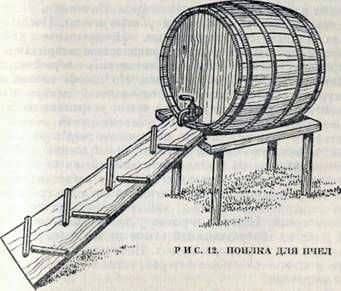
To grow the brood and keep the optimum humidity and temperature in the nest, bees need water. On average, the bee family spends 50 grams of water per day, and in hot and dry days – 300-400 g.
In the greenhouses with the appearance in the brood nests, the bees accumulate near leaking faucets and hoses. When processing plants in this place can get a pesticide, which will cause poisoning of bees. To avoid this, in the opposite side of the hive, it is desirable to put a bowl of sawdust into which water should be poured daily. Once a week, the plate needs to be washed and changed with sawdust. For the period of chemical treatment of plants, the drinking bowl is covered.
The need for water encourages bees to fly to her search at a temperature lower than the bribe. After a long storm, the bees of strong families are already flying at a temperature of 4 њ C in the shade in search of water and; often die from cold and wind.
In order to avoid the death of bees and provide them with water in the warmed windless area of the apiary at the end of the 2nd or on the 3rd day after flying over the bees, a drinking bowl is installed.
The drinking pot can also be put on the 1st day of flying over the bees, but to prevent contamination by beating the bees and spreading nosematosis over the drinker, the film is temporarily stretched at a height of 1-1.5 m.

For drinking bees, a tank is used, from which water drips onto a board with a slight inclination and a zigzag-like chute. Bees are more likely to visit the drinking bowl if the water in the tank is poured warm and lightly salted with table salt at the rate of 50 g of salt per bucket of water. It is better if there are 2 drinkers on the apiary: one with salted water and the other with fresh water. Cobalt and other useful substances required for bees can be added to the water.
Despite the fact that there are drinkers with heated water in the apiary, many bees take water from the glazing of the roof of the greenhouses, it is possible that the water is warmer there or they find the microelements necessary for them. Beekeepers have long observed that bees like to take water from dung puddles. They thought that they were attracted by mineral salts. And only recently it was found that in the manure puddles a lot of vitamin B12 is produced, produced by the intestinal bacteria of animals and man, partially emitted with feces. Bee vitamins of group B, as it was said above, are necessary. This probably attracts bees to sewage.
Perhaps adding vitamin B12 to the drinker will distract the bees from visiting the sewage, but will this cost justify the event. It is known that with the beginning of the arrival of the pollen in the beehive, the number of bees in the manure puddles decreases.
On amateur apiaries it is possible to use individual drinkers, installed in the hive, over the frames, on the landing board, at the upper tap. Water can be poured into one of the honeycombs and put it close to the bees nesting bees. Thanks to the individual bees of the spring, they grow brood more, the family grows faster, and the beekeeper receives much more commercial honey.
In greenhouses, where bee colonies may be weaker than on commodity apiaries, individual bees will allow to fully preserve and timely increase bees to the main honey collector.
Барбарисовый мед. Подкормка маток.
Hothouse beekeeping